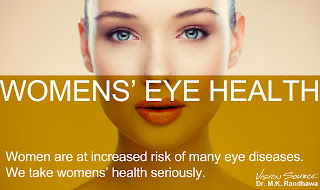Research presented recently at the 2013 Meeting of the American Academy of Ophthalmology in New Orleans, shows that women who have taken oral contraceptives for three or more years are twice as likely to suffer from
glaucoma. Glaucoma is one of the leading causes of blindness and vision lost to glaucoma is lost permanently. Glaucoma slowly takes your vision, starting at the periphery and working its way to the center. Many people with glaucoma don't know that they have it until it is too late. The only way to detect glaucoma early enough for effective treatment is through a regular eye exam.
This is normal vision:
This is vision with glaucoma in its advanced stages:
The study looked at 3,406 American women aged 40 years or older who completed a vision and reproductive health questionnaire and underwent eye exams. The researchers found that females who had used oral contraceptives, no matter which kind, for more then three years were 2.05 times more likely to also report that they had also been diagnosed with glaucoma.
The study means that women who have taken oral contraceptives for more than three years should have a regular eye exam to screen for the early onset of glaucoma. Other risk factors for glaucoma include elevated pressure inside the eye, visual field deficits, family history,
South Asian or African ancestry, a history of
myopia and other risk factors. See your eye doctor if you are concerned.
The study rings another note of caution for women when it comes to eye health. Women are at significantly higher risk than men for many eye diseases and must therefore ensure that they are vigilant about their eye health. Read about women's eye health at the link below:












The study examined the comfort reported by patients throughout and at the end of a 10-hour day of wear. Subjects were surveyed on a 0–100 scale for comfort on two separate days.
On the first day, nothing was done to the lenses they wore throughout the day, and study participants reported decreasing comfort during the day. This result was expected, as many optometrists observe this in the clinic. Doctors have long argued about the cause of this discomfort. Was it due to ill-fitting lenses? Or was it due to changes in the surface of the eye caused by contact lens wear?
To answer that question, on the second day the lenses were removed after 5 hours of wear. After removal, either the same lens was reinserted, or it was replaced and a new lens. The assumption was that if lens comfort improved by removing and replacing the same lens, then the surface of the eye was to blame. On the other hand, if comfort improved after switching to a new lens, then the fit of the lens may be at fault. The control group wore lenses continuously for 10 ours with no reinsertion or switching to a new lens.
The results showed that there was no difference between the control group (that wore the lenses continuously for 10 hours) and either the group that removed and reinserted the same lens or the group that switched to a new lens. This lead the researchers to conclude that the increasing discomfort throughout the day was not related to the lenss. They suggested that the likely cause of increasing discomfort was a "fatigue-like response in one or more ocular tissues or stimulation of ocular surface nociceptors induced by the presence of the contact lens."
Source